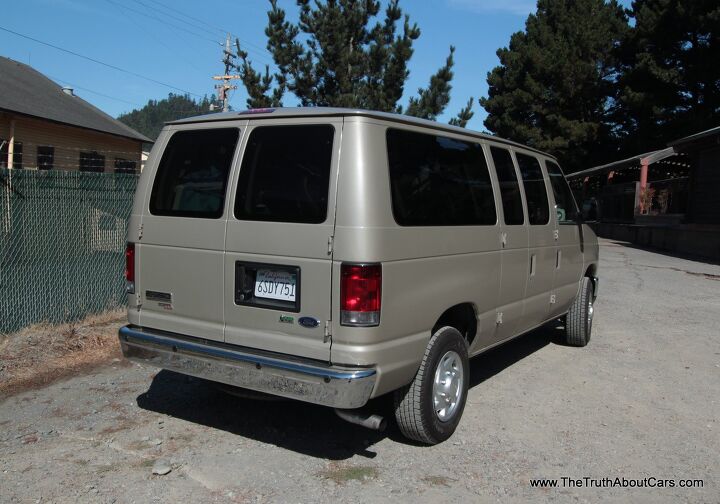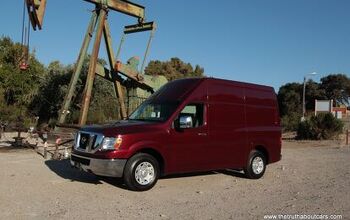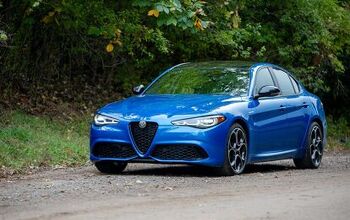Commercial Week Day Three Review: 2012 Ford E-Series Cargo Van

Our look at Nissan and GM’s van offerings would be out-of-place without including the Van “built Ford tough”. We know that the E-Series days are numbered – Ford recently announced the American Transit van T-Series will come with the holy grail of Ford powertrains, the 3.5L twin-turbo Ecoboost V6. Turbo love aside, is it wise to stock up on old-school vans before the trendy new models come on the scene? If you’re worried about new model glitches and want a van that’s as old as time, with a bullet-proof Ford modular V8 and a transmission that’s a bit shy on gears, it might just be your choice. With the E-Series’ days numbered and the commercial vehicle segment being as exciting as Wonder Bread, the lack of press fleet vans was no surprise. What’s a rag like TTAC to do? Spend a week in a Hertz special.
Although we ended up with a passenger van, and not a commercial van, all E-series vans feature a large front grille and longer hood thanks to a refresh in 2008 to make them look more like the F-series. Wagon and recreation vans use aerodynamic headlamp modules and acres of chrome, while base commercial cargo haulers have a blacked out grille and sealed beam headlamps. The chrome bling and modern headlamps look decidedly more attractive, but on a practicality level there’s a problem: those snazzy duds are more expensive to repair when John Doe (your least careful employee) rear-ends Ms Daisy on Main Street. For $235 Ford will sell you their middle-of-the-road package which retains the black bumper cover but upgrades the lamps and grille. I’d stick with the base model if you’re not driving your own van. Out back the E-series vans all feature swing-out doors that open to a full 178 degrees making them almost as useful as the doors in the Nissan NV (the NV’s essentially fold flat to the side of the van) and more convenient than the 165 degree doors on the GM competition. Like GM, Ford offers your choice of a sliding or 60/40 split side door.
Our E-350’s interior is circa 2009, when Ford raided the Super Duty parts bin which means Ford’s SYNC radio and navigation units are on the E-series menu, a notable upgrade from GM’s infotainment options. Should your fleet need some big brother love, the CrewChief GPS tracking and monitoring system is available on most models. Our van was a rental, which meant of course that it had been driven hard, put away wet and had a vague aroma of spoilt milk and dog urine. This wasn’t some primped press car folks. After a quick wipe-down to prepare it for the camera, it was obvious the hard plastics inside were built to last showing little wear, just like the GM and Nissan offerings. On the creature comfort side, A/C is standard and Ford makes a backup cam, backup sensors and the aforementioned navigation system with SYNC optional. Volume purchasers beware, adding SYNC will bump your MSRP up $1,010 as it requires you upgrade to the four-speaker package and inexplicably you must add cruise control to the party. If those items were already on your menu, then SYNC (with Bluetooth) itself becomes a $475 bump. Ford also offers an integrated trailer brake controller for $230 and a set of in-dash auxiliary switches (the same as in the Super Duty trucks) for $85 making it easier to pimp your ride.
If the phrase “all-new drivetrains” sets your loins on fire, skip this section. Ford offers a limited engine selection compared to GM – two V8s and a V10. The observant will notice that a V6 or diesel V8 option are conspicuous by their absence (the V6 was dropped in 2008 and the diesel in 2009). While Ford markets the E-150 as the only full-sized van with a standard V8, I’m not sure 225HP and 286lb-ft (13/17MPG) are anything to trumpet when Buick’s 2.0L turbo four cylinder beats both figures and delivers them across a broader range (durability concerns aside of course). The optional 5.4L V8 bumps the power figures to (a still less than competitive) 255HP and 350lb-ft (12/16MPG) and was the engine in our rental. Even empty acceleration was sluggish and when loaded with 5 passengers and a weekend’s camping gear it was best described as “glacial”. The problem is not the 255HP, the Ford’s ancient 4-speed automatic which is the only transmission available with either V8. GM’s base 4.8L V8 may deliver less torque at 295lb-ft, yet combined with the modern 6-speed transmission the GM van never feels out of breath even in mountainous terrain. The E-Series on the other-hand often seemed like it was hunting for a gear that didn’t exist, especially on mountain highways and in steep urban settings. Ford’s optional 6.8L V10 brings a newer 5-speed auto, but it is still a cog behind GM. Despite superficially healthy numbers for the Ford V8 (305HP/420lb-ft), GM counters with a 6.0L V8 at 324HP/373lb-ft and one extra gear making it yet again the performance and “driveability” winner. On the green-cred front, Ford’s V8 engines can be ordered with liquid propane or compressed natural gas prep packages; all you do is have a conversion company add the gas cylinders. Beware though, that the CNG conversion costs $13,000. While your gaseous E-Series may deliver fewer MPGs on the road and the “savings” are dubious, California and a few select states will allow solo CNG drivers in the HOV lanes with permanent stickers if your conversion is done at the time of purchase.
A van’s mission is to shift the most stuff. Both Ford and GM offer extended vans to swallow more, but how they extend differs. Ford offers an extended body while GM extends both the wheelbase and the body. Neither option is an outright winner so which option is better? That depends on what you’re hauling and where. GM’s regular wheelbase of 135 inches is shorter than the E-series’s 138 inch model and this helps GM’s V6 van be the most nimble with a 43-foot turning circle vs the E-Series standard 48-foot. Adding the V8 to GM’s van bumps the circle to 49-feet. The E-Series’ standard 216-inch length (vs the 224-inch long Express) is responsible for its slightly smaller cargo capacity able to swallow 12.5-foot long items vs GM’s standard 13-foot sword swallowing ability. Extending the rear of the E-Series takes cubic cargo capacity from 237 cubic feet to 278 cubic feet and allowed 14.6-foot items to be carried from the dash to the rear doors, while that sounds good, GM’s extended wheelbase vans measure in at a whopping 20-feet-5-inches holding 313 cubic feet of cargo and swallowing items that are 16-feet long (if placed carefully inside). The downside to GM’s wheelbase stretch is the enormous 54-foot turning circle making U-turns difficult even on the widest of expressways. The upside of the extension is superior handling when the cargo area is full by spreading the weight more evenly between the front and rear axles.
As my week with the E-Series van came to a close I had more questions than answers. Why would anyone that owned and operated their own van buy the Ford van over the Nissan NV which offers more creature comforts, more power and better fuel economy? Similarly, who would a large commercial customer buy the E-Series van over GM’s Express/Savana van with a wider selection of options, heavy-duty six-speed transmissions, greater hauling capacity and better fuel economy? At the end of the day the E-Series is a tired workhorse that knows it’s being sent to pasture, yet sales remain high for one reason; companies like a homogeneous fleet. Fleet buyers like being able to buy the same van they brought 10 years ago, knowing the same custom widgets will bolt right on. Perhaps that’s why Ford has pledged that the E-Series will soldier on even after the introduction of the Transit T-Series in America. With an advertised 25% better fuel economy on tap, let’s hope Ford can convince the commercial buyer lemmings to switch to a better product rather than defect to the competition.
This is part three of a five-part series on commercial vehicles. Click the links below for the others in this series
2012 Chevrolet Express / GMC Savana
TTAC searched high and low, found the best web coupons and rented an E-350 van for a week for this review. Gas was expensive and not included.
Specifications as tested
0-60: 10.1 Seconds
Average fuel economy: 10.4MPG over 896 miles

More by Alex L. Dykes
Latest Car Reviews
Read moreLatest Product Reviews
Read moreRecent Comments
- Ltcmgm78 It depends on whether or not the union is a help or a hindrance to the manufacturer and workers. A union isn't needed if the manufacturer takes care of its workers.
- Honda1 Unions were needed back in the early days, not needed know. There are plenty of rules and regulations and government agencies that keep companies in line. It's just a money grad and nothing more. Fain is a punk!
- 1995 SC If the necessary number of employees vote to unionize then yes, they should be unionized. That's how it works.
- Sobhuza Trooper That Dave Thomas fella sounds like the kind of twit who is oh-so-quick to tell us how easy and fun the bus is for any and all of your personal transportation needs. The time to get to and from the bus stop is never a concern. The time waiting for the bus is never a concern. The time waiting for a connection (if there is one) is never a concern. The weather is never a concern. Whatever you might be carrying or intend to purchase is never a concern. Nope, Boo Cars! Yeah Buses! Buses rule!Needless to say, these twits don't actual take the damn bus.
- MaintenanceCosts Nobody here seems to acknowledge that there are multiple use cases for cars.Some people spend all their time driving all over the country and need every mile and minute of time savings. ICE cars are better for them right now.Some people only drive locally and fly when they travel. For them, there's probably a range number that works, and they don't really need more. For the uses for which we use our EV, that would be around 150 miles. The other thing about a low range requirement is it can make 120V charging viable. If you don't drive more than an average of about 40 miles/day, you can probably get enough electrons through a wall outlet. We spent over two years charging our Bolt only through 120V, while our house was getting rebuilt, and never had an issue.Those are extremes. There are all sorts of use cases in between, which probably represent the majority of drivers. For some users, what's needed is more range. But I think for most users, what's needed is better charging. Retrofit apartment garages like Tim's with 240V outlets at every spot. Install more L3 chargers in supermarket parking lots and alongside gas stations. Make chargers that work like Tesla Superchargers as ubiquitous as gas stations, and EV charging will not be an issue for most users.



















































Comments
Join the conversation
I've driven both Ford and Chevy vans tens of thousands of miles at work in the last fifteen years . The company owned both Ford and Chevy extended but I also drove many new rental vans too . If it's a rental I'd much prefer the Ford- it's built better and feels more solid . But,I don't know how typical our experience was but the Econoline with the Triton engine was at the end of its life at less than 200k miles . By then it needed a new trans and A.C compressor-both for the second time ,had no brakes and needed some valve work . Always hated the Chevy Express for its crappy interior- the door panels fell apart repeatedly , the crappy hard edged cut-yourself plastics , the U.A.W. at its uncaring worst assembly quality - but it was much more reliable and still running well at 200k miles .Both were driven hard but maintained reasonably well . Other Ford van owners I've known had similiar transmission woes and it seemed to be very difficult to get a decent rebuild .I was most impressed with the Ford when I was hit by a Ford F-150 truck which hit me going about 20 m.p.h.. The truck was totalled , but the van , though badly damaged was easily repaired and I wasn't scratched . It helped that the F-150 front bumper matched the van's rear bumper perfectly .
I have to admit, I own a 2009 E-150 8 passenger van with the 4.6l V-8. My Wife and I primariliy use it as a kid hauler (we have 5 kids) and it works great for that. The van we we have is an ex-vanpool lease, and we bought it with about 90k miles on it. From the reciepts I found inside the van, was well taken care of by the lease company that used to own it. My kids love the big captains chairs, and my wife likes being able to get the kids in and out easier than our old mini-van. Also, in Southern California, you can pick these vans up cheap! We got ours for less than $10k, and I think it will last us for quite a few years.